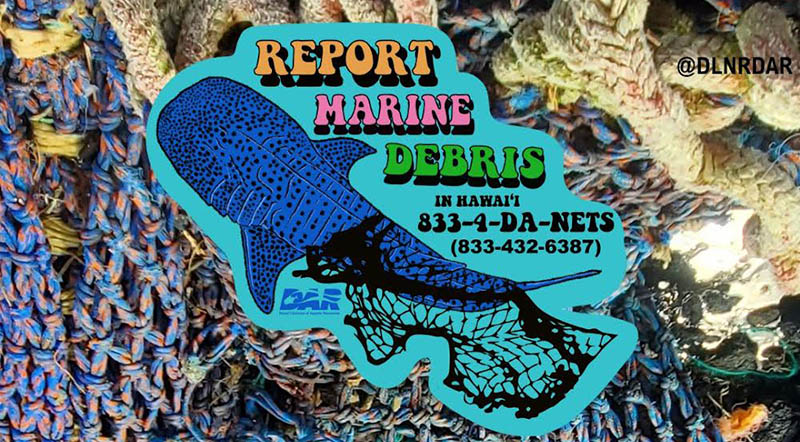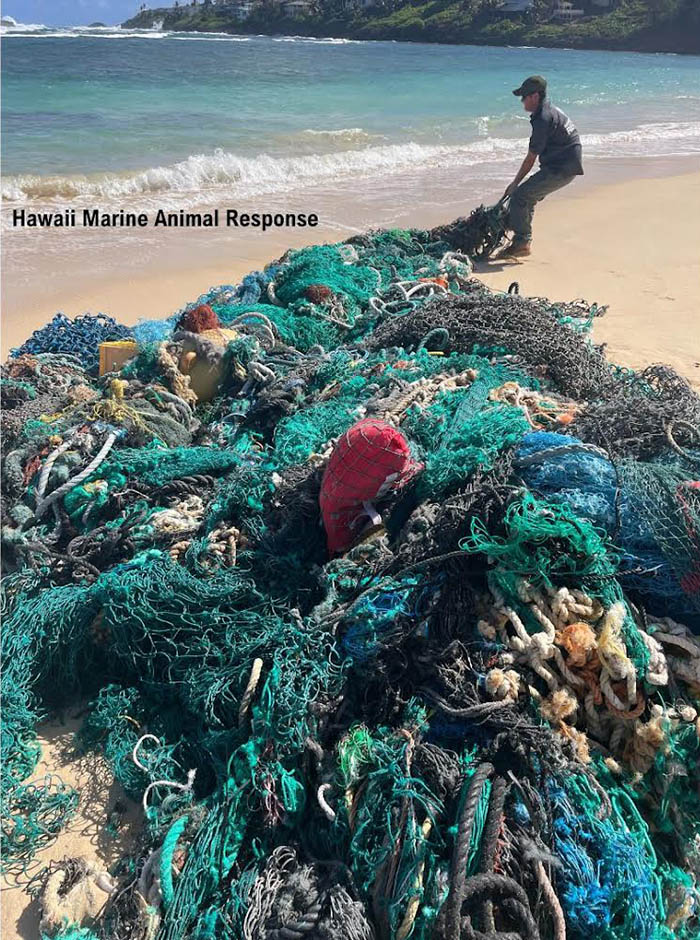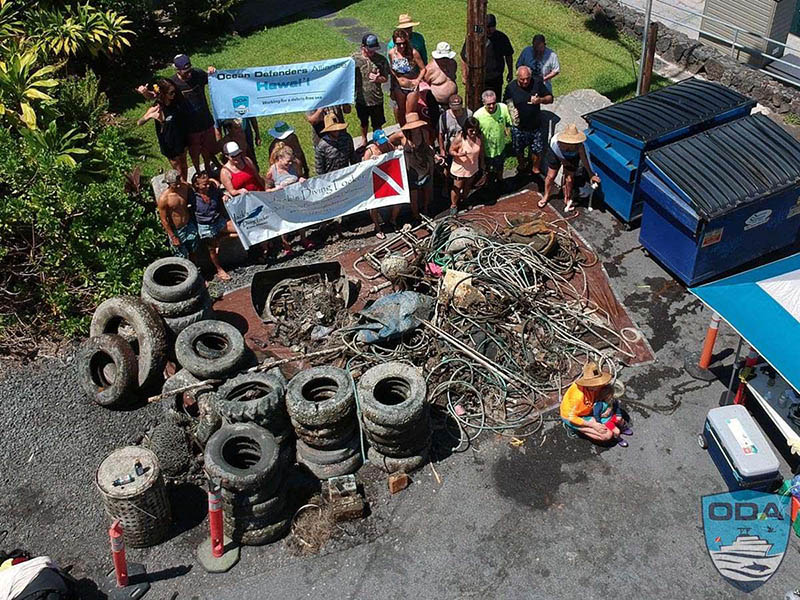Report Marine Debris
Please Kōkua:
Report Marine Debris in Hawaiʻi

Entanglement hazards such as nets, ropes and lines are extremely harmful for Hawaii’s marine wildlife and coral reefs – please help us remove these entanglement hazards as soon as possible!
How YOU can help: Please report large quantities of marine debris on land or in the water (or any debris too large to remove by hand) by calling our DLNR-DAR’s Marine Debris Rapid Response Program hotline:
833-4-DA-NETS (833-432-6387)
When you call the 833-4DA-NETS hotline you will reach an automated system that routes you to the correct island contact:
Press 1 – to report an abandoned or grounded vessel;
To report derelict fishing gear, such as nets, lines, ropes, or other large & hazardous marine debris items by island:
Press 2 – for Oʻahu
Press 3 – for Maui
Press 4 – for Hawai‘i Island
Press 5 – for Kaua‘i
Press 6 – for Molokaʻi
You can also report marine debris through the DLNR Reporting form online by uploading your photos and GPS location. This option immediately contacts multiple DLNR, university and nonprofit staff members. Please use this reporting portal for larger items such as boats, containers, and any other large debris.
If you encounter in-water debris that is very large and deemed a NAVIGATION HAZARD call the U.S. Coast Guard immediately to report a hazard to navigation: CG Sector Command Center: (808) 842-2600

Marine debris (a.k.a. plastic pollution) is an issue across the globe. Hawaiʻi is in the middle of the Pacific Ocean and collects marine debris from all coastlines that touch and ships that traverse the Pacific Basin. Marine debris has grown to be a major global environmental issue, presenting direct entanglement and ingestion hazards for marine species in all oceans (and across other environments too). Marine debris has harmed and killed countless species of dolphins, whales, fish, seabirds, and other aquatic creatures, as well as our endangered Hawaiian monk seals and hawksbill sea turtles, and threatened green sea turtles. Derelict fishing gear such as large fishing nets, rope and line are also hazardous for Hawaii’s coral reefs – as it can smother, snag, and break corals that are such an important part of the nearshore ecosystem.

As such, it is important we get these nets and ropes off Hawaii’s shorelines as quickly as possible to reduce the amount of damage they can do to our native species and ecosystems. The Department of Land and Natural Resources’ (DLNR) Division of Aquatic Resources (DAR) has organized a Marine Debris Rapid Response Program for the State of Hawaiʻi since 2021. From October 2021 to December 31, 2024, contracted marine debris removal organizations have collectively removed 191,177 pounds of marine debris from Hawaii’s coastlines, reefs, and oceans.
This program is composed of several nonprofit, for-profit and nongovernmental organizations. DAR has two separate contracts on each island:
- Scuba or Free-diving Removal of: In-water marine debris such as fishing line, lead, tires and more.
- Removal of large entanglement hazards such as: Shoreline Derelict fishing gear, ropes, nets, etc. These contractors are also responsible for answering marine debris hotline phone calls as well as the DLNR Reporting form.
Marine Debris response partners are contracted annually – if you are interested in applying to this marine debris rapid response hotline, please email [email protected]

2025 partner organizations on contract with DLNR- Division of Aquatic Resources (May 2025 – May 2026):
 Kauaʻi:
Kauaʻi:
Marine Debris (MD) rapid response partner: Hawaiʻi Wildlife Fund- Surfrider Foundation Kauaʻi
In-water MD removal partner: Ho’oomalu Ke Kai
Oʻahu:
MD rapid response partner: Hawaiʻi Marine Animal Response (HMAR)
In-water MD removal partner: Hawaiʻi Marine Animal Response (HMAR)
Molokaʻi:
MD rapid response partner: Hawaiʻi Marine Animal Response
Maui:
MD rapid response partner: Pacific Whale Foundation
In-water MD removal partner: Partnership between; HAMER- Hawaiʻi Association for Marine Education and Research inc., Maui Ocean Center Marine Institute (MOCMI), & Sharkastics
Hawaiʻi (Big) Island:
MD rapid response partner: Hawaiʻi Wildlife Fund
In-water MD removal partner: Ocean Defenders Alliance

Hawaii Pacific University’s- Center for Marine Debris Research also has a Derelict Fishing Gear- Bounty project that pays Hawaii Permitted commercial fishermen for removal of derelict fishing gear- this program is also an integral part of keeping Hawaii’s oceans ecosystems healthy. If you are a commercial fisherman and are interested in this program please see the link above for more information as well as how to register.
Marine debris is very harmful for wildlife and their habitat whether it is big or small. Our rapid response program focuses primarily on larger debris, and items that present entanglement hazards to our protected marine species. However, microplastic (and smaller) marine debris is finding its way into wildlife (and our) food webs, and impacting species on a physiological level, with unknown indirect effects on biological function. The more we opt away from single-use and “throwaway” plastics as a society, and become more mindful about our waste disposal at a County-by-County level, and rethink the materials we are using for recreational / commercial fishing and agriculture, the better!

Plastic pollution (marine debris) is a people problem, so it will take the collaboration and cooperation by a diverse group of humans across the globe to stem this tide of trash. We welcome new and creative partnerships to better protect aquatic wildlife in Hawaiʻi Nei and are most grateful to our current and past partners that have allowed us to already make a measurable difference in the amount of marine debris in the environment.
